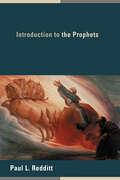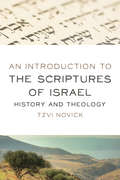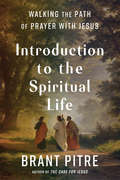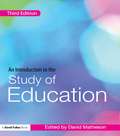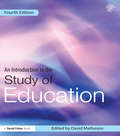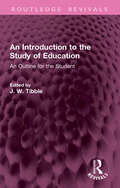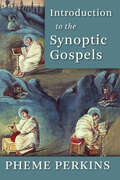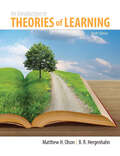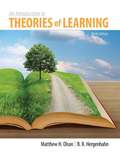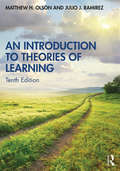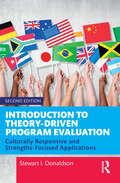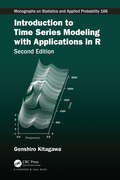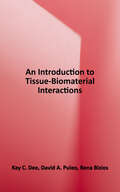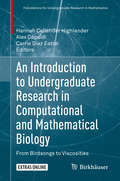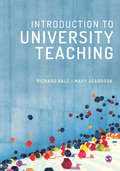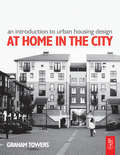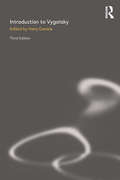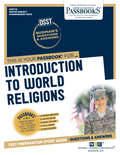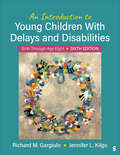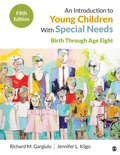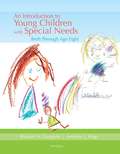- Table View
- List View
Introduction to the Prophets
by Paul L. ReddittWriting in a conversational rather than a scholarly tone, Paul Redditt assumes little or no prior knowledge of the Old Testament as he presents and introduces the Major and Minor Prophets in the canonical order of the English Bible. The chapters of Redditt's Introduction to the Prophets discuss the place of each book in the canon; the literary setting of each book; their structure, integrity, and authorship; the main genre(s) in each; special features of each book; basic emphases of each book; and problems -- theological, literary, or historical -- raised by a study of the book. Among other things, Redditt demonstrates that the prophets were both &“foretellers&” and &“forthtellers,&” and he argues that the Old Testament prophets developed the concept of monotheism. Each chapter ends with questions for further reflection. Concluding the volume are a helpful glossary and several indexes.
An Introduction to the Scriptures of Israel: History and Theology
by Tzvi NovickIn this distinctive textbook for Hebrew Bible courses, author Tzvi Novick&’s approach is thematic rather than chronological. Sorting the books according to their historical context, theological claims, and literary conventions, Novick examines and elucidates the historical and intellectual development of the Hebrew Bible. With attentiveness to both historical-critical and traditional-canonical approaches, An Introduction to the Scriptures of Israel focuses on the dichotomy of the particular and the universal. It shows how this dichotomy impacts each book&’s style and content and how it informs the development of Jewish and Christian traditions. This nontraditional textbook is coherent, engaging, and succinct—a perfect resource for any introductory Hebrew Bible course.ContentsPreface Abbreviations 1. Three Introductions 2. The Wisdom Tradition: Religion without Revelation 3. Revelation and Love: The Patriarchal Narratives and the Song of Songs 4. Joseph and Narrative 5. The Exodus: Freedom and Sonship 6. Sinai: Covenant and Code 7. The Problem of Monarchy: Samuel and Kings 8. Condemning Israel, Sparing the Nations: Amos and Jonah 9. Eden and the Art of Reading 10. Priestly Theology and Holy Space 11. Exile and Return: Prophetic Visions 12. The Consolidation of Judaism: Temple and Torah 13. Violence and Identity: Joshua and Judges 14. Jews, Gentiles, and Gender: Esther, Ruth, Ezra, and Nehemiah 15. Apocalyptic: Daniel and the Dead Sea Scrolls 16. The Israelite at Prayer: The Book of PsalmsSubject Index Scripture and Other Ancient Sources Index
An Introduction to the Scriptures of Israel: History and Theology
by Tzvi NovickIn this distinctive textbook for Hebrew Bible courses, author Tzvi Novick&’s approach is thematic rather than chronological. Sorting the books according to their historical context, theological claims, and literary conventions, Novick examines and elucidates the historical and intellectual development of the Hebrew Bible. With attentiveness to both historical-critical and traditional-canonical approaches, An Introduction to the Scriptures of Israel focuses on the dichotomy of the particular and the universal. It shows how this dichotomy impacts each book&’s style and content and how it informs the development of Jewish and Christian traditions. This nontraditional textbook is coherent, engaging, and succinct—a perfect resource for any introductory Hebrew Bible course.ContentsPreface Abbreviations 1. Three Introductions 2. The Wisdom Tradition: Religion without Revelation 3. Revelation and Love: The Patriarchal Narratives and the Song of Songs 4. Joseph and Narrative 5. The Exodus: Freedom and Sonship 6. Sinai: Covenant and Code 7. The Problem of Monarchy: Samuel and Kings 8. Condemning Israel, Sparing the Nations: Amos and Jonah 9. Eden and the Art of Reading 10. Priestly Theology and Holy Space 11. Exile and Return: Prophetic Visions 12. The Consolidation of Judaism: Temple and Torah 13. Violence and Identity: Joshua and Judges 14. Jews, Gentiles, and Gender: Esther, Ruth, Ezra, and Nehemiah 15. Apocalyptic: Daniel and the Dead Sea Scrolls 16. The Israelite at Prayer: The Book of PsalmsSubject Index Scripture and Other Ancient Sources Index
Introduction to the Spiritual Life: Walking the Path of Prayer with Jesus
by Brant PitreA compelling exploration of the biblical foundations, contemplative practices, and spiritual path of Jesus himself—from the bestselling author of The Case for Jesus&“What happens when a biblical theologian explores classic spirituality? This book. Pitre&’s students have asked, Why have we never heard this before? The reader wonders the same.&”—Dr. David Fagerberg, author of Liturgical Mysticism The path of following Jesus is an ancient and storied spiritual tradition. Yet many believers are not familiar with the three major forms of prayer and the three stages of spiritual growth that exist to bring them closer to God.In his most personal book yet, Dr. Brant Pitre draws on the riches of the Bible, the words of Jesus, and the writings of mystics across the centuries to shed light on the mystery—and wonder—of the spiritual life.Starting with the age-old belief that the path of prayer is not only informative but transformative, Dr. Pitre explores• the scriptural roots of vocal, meditative, and contemplative prayer• the purgative, illuminative, and unitive stages of spiritual growth• the spiritual exercises of prayer, fasting, and almsgiving• the Jewish roots of the Lord&’s Prayer• Lectio Divina: how to pray with the Bible• seven vices and their seven opposing virtues• the battle of prayer: how to deal with difficulty and distractions• the &“dark night of the soul&” in the ScripturesFull of sacred truths, contemplative insights, and practical steps, Introduction to the Spiritual Life is a veritable biblical road map of the spiritual landscape that enables us to follow Jesus as our primary guide.
An Introduction to the Study of Education
by David MathesonThis fully updated, fourth edition of An Introduction to the Study of Education provides a comprehensive and reflective introduction to the study of education, inviting students to question what education is, who it is for and what purpose it serves. Taking the reader from the early years through to lifelong learning, it examines all forms of education and learning. This new edition includes ten completely new chapters and a step-by-step guide to essay writing. There is also a companion website to accompany the book, featuring additional chapters which can be visited at www.routledge.com/cw/matheson.This fully updated, fourth edition provides: a full exploration of the historical, sociological, philosophical and psychological roots of education; a clear focus on the individual levels of education - preschool, compulsory, post-compulsory and lifelong learning; the latest debates within special educational needs; an in-depth examination of learning styles; insights into the historical development of education and the role of, and background to, research in education; a focus on current educational practice and diversity across the United Kingdom and Ireland. Written in a clear and accessible style, this is the essential core text for all beginning students on undergraduate and postgraduate courses in Education Studies and all those interested in education today, where it came from and where it is going.
An Introduction to the Study of Education
by David MathesonThis fully updated, fourth edition of An Introduction to the Study of Education provides a comprehensive and reflective introduction to the study of education, inviting students to question what education is, who it is for and what purpose it serves. Taking the reader from the early years through to lifelong learning, it examines all forms of education and learning. This new edition includes ten completely new chapters and a step-by-step guide to essay writing. There is also a companion website to accompany the book, featuring additional chapters which can be visited at www.routledge.com/cw/matheson.This fully updated, fourth edition provides: a full exploration of the historical, sociological, philosophical and psychological roots of education; a clear focus on the individual levels of education – preschool, compulsory, post-compulsory and lifelong learning; the latest debates within special educational needs; an in-depth examination of learning styles; insights into the historical development of education and the role of, and background to, research in education; a focus on current educational practice and diversity across the United Kingdom and Ireland. Written in a clear and accessible style, this is the essential core text for all beginning students on undergraduate and postgraduate courses in Education Studies and all those interested in education today, where it came from and where it is going.
An Introduction to the Study of Education: An Outline for the Student (Routledge Revivals)
by J. W. TibbleFirst Published in 1971, An Introduction to the Study of Education is a basic introduction to the curriculum of education which will be of interest to students in colleges of education as well as to sixth formers. The six contributors, all well known in the educational field, consider different aspects of the study of education. J.W. Tibble himself considers the development of the study of education. D.J. Watts contributes a chapter on educational psychology. Anne Dufton looks at the sociology of education, while its history is examined by Malcolm Seaborne and its philosophy by R.F. Dearden. The relationship between theory and practice is considered by Harold Entwistle, and a final chapter, by J.W. Tibble, looks at the curriculum courses available in Britain.
Introduction to the Synoptic Gospels
by Pheme PerkinsIn this book respected New Testament scholar Pheme Perkins delivers a clear, fresh, informed introduction to the earliest written accounts of Jesus — Matthew, Mark, and Luke — situating those canonical Gospels within the wider world of oral storytelling and literary production of the first and second centuries. Cutting through the media confusion over new Gospel finds, Perkins’s Introduction to the Synoptic Gospels presents a balanced, responsible look at how the Gospels of Matthew, Mark, and Luke came to be and what they mean.
Introduction to Theories of Learning: Ninth Edition
by Matthew H. OlsonDefines learning and shows how the learning process is studied. Clearly written and user-friendly, Introduction to the Theories of Learning places learning in its historical perspective and provides appreciation for the figures and theories that have shaped 100 years of learning theory research. The 9th edition has been updated with the most current research in the field. With Pearson's MySearchLab with interactive eText and Experiment's Tool, this program is more user-friendly than ever. Learning Goals Upon completing this book, readers should be able to: Define learning and show how the learning process is studied Place learning theory in historical perspective Present essential features of the major theories of learning with implications for educational practice Note: MySearchLab does not come automatically packaged with this text. To purchase MySearchLab, please visit: www.mysearchlab.com or you can purchase a ValuePack of the text + MySearchLab (at no additional cost).
An Introduction to Theories of Learning
by Matthew H. Olson B. R. HergenhahnDefines learning and shows how the learning process is studied. Clearly written and user-friendly, Introduction to the Theories of Learning places learning in its historical perspective and provides appreciation for the figures and theories that have shaped 100 years of learning theory research. The 9th edition has been updated with the most current research in the field. Learning Goals Upon completing this book, readers should be able to: Define learning and show how the learning process is studied Place learning theory in historical perspective Present essential features of the major theories of learning with implications for educational practice. <P><P><i>Advisory: Bookshare has learned that this book offers only partial accessibility. We have kept it in the collection because it is useful for some of our members. Benetech is actively working on projects to improve accessibility issues such as these.</i>
An Introduction to Theories of Learning
by Matthew H. Olson Julio J. RamirezSince its first edition, An Introduction to Theories of Learning has provided a uniquely sweeping review of the major learning theories from the 20th century that profoundly influenced the field of psychology. In this tenth edition, the authors present further experimental evidence that tests many of the fundamental ideas presented in these classic theories, as well as explore many of the advances in psychological science and neuroscience that have yielded greater insight into the processes that underlie learning in human beings and animals. The four main goals of this text are to define learning and to show how the learning process is studied (Chapters 1 and 2), to place learning theory in historical perspective (Chapter 3), and to present essential features of the major theories of learning with implications for educational practices (Chapters 4 through 16). The authors retained the best features of earlier editions while making revisions that reflect current research and scholarship, including coverage of active learning and the testing effect, information for problem solving in ravens, data illustrating the neurobiological basis of the cognitive map and spatial learning, new research on brain plasticity and its role in learning as well as the impact of poverty on brain and cognitive development, and new evidence that challenges the notion of learning styles. Complete with chapter summaries, discussion questions, glossary, and online resources for instructors, this text is essential reading for theories of learning and applied cognitive psychology courses.
Introduction to Theory-Driven Program Evaluation: Culturally Responsive and Strengths-Focused Applications
by Stewart I. DonaldsonIntroduction to Theory-Driven Program Evaluation provides a clear guide for practicing evaluation science, and numerous examples of how these evaluations actually unfold in contemporary practice. A special emphasis is placed how to conduct theory-driven program evaluations that are culturally responsive and strengths-focused. In this thoroughly revised new edition, author Stewart I. Donaldson provides a state-of-the art treatment of the basics of conducting theory-driven program evaluations. Each case follows a three-step model: developing program impact theory; formulating and prioritizing evaluation questions; and answering evaluation questions. The initial chapters discuss the evolution and popularity of theory-driven program evaluation, as well as step-by-step guide for culturally responsive and strengths-focused applications. Succeeding chapters provide actual cases and discuss the practical implications of theory-driven evaluation science. Reflections, challenges, and lessons learned across numerous cases from practices are discussed. The volume is of significant value to practicing evaluators, professors of introductory evaluation courses and their students, advanced undergraduate and graduate students, and serves as a text or a supplementary text for a wide range of evaluation and applied research courses. It is also of great interest to those interested in the connections between work and health, well-being, career development, human service organizations, and organizational improvement and effectiveness.
Introduction to Time Series Modeling with Applications in R (Chapman & Hall/CRC Monographs on Statistics and Applied Probability)
by Genshiro KitagawaPraise for the first edition: [This book] reflects the extensive experience and significant contributions of the author to non-linear and non-Gaussian modeling. … [It] is a valuable book, especially with its broad and accessible introduction of models in the state-space framework. –Statistics in Medicine What distinguishes this book from comparable introductory texts is the use of state-space modeling. Along with this come a number of valuable tools for recursive filtering and smoothing, including the Kalman filter, as well as non-Gaussian and sequential Monte Carlo filters. –MAA Reviews Introduction to Time Series Modeling with Applications in R, Second Edition covers numerous stationary and nonstationary time series models and tools for estimating and utilizing them. The goal of this book is to enable readers to build their own models to understand, predict and master time series. The second edition makes it possible for readers to reproduce examples in this book by using the freely available R package TSSS to perform computations for their own real-world time series problems. This book employs the state-space model as a generic tool for time series modeling and presents the Kalman filter, the non-Gaussian filter and the particle filter as convenient tools for recursive estimation for state-space models. Further, it also takes a unified approach based on the entropy maximization principle and employs various methods of parameter estimation and model selection, including the least squares method, the maximum likelihood method, recursive estimation for state-space models and model selection by AIC. Along with the standard stationary time series models, such as the AR and ARMA models, the book also introduces nonstationary time series models such as the locally stationary AR model, the trend model, the seasonal adjustment model, the time-varying coefficient AR model and nonlinear non-Gaussian state-space models. About the Author: Genshiro Kitagawa is a project professor at the University of Tokyo, the former Director-General of the Institute of Statistical Mathematics, and the former President of the Research Organization of Information and Systems.
An Introduction to Tissue-Biomaterial Interactions
by Rena Bizios David A. Puleo Kay C. DeeThis book acquaints an undergraduate audience with the fundamental biological processes that influence these sophisticated, cutting-edge procedures. Chapters one through three provide more detail about the molecular-level events that happen at the tissue-implant interface, while chapters four through ten explore selected material, biological, and physiological consequences of these events. The importance of the body’s wound-healing response is emphasized throughout. Specific topics covered include: Structure and properties of biomaterials - Proteins - Protein-surface interactions - Blood-biomaterial interactions - Inflammation and infection - The immune system - Biomaterial responses to implantation - Biomaterial surface engineering - Intimal hyperplasia and osseointegration as examples of tissue-biomaterial interactions The text also provides extensive coverage of the three pertinent interfaces between the body and the biomaterial, between the body and the living cells, and between the cells and the biomaterial that are critical in the development of tissue-engineered products that incorporate living cells within a biomaterial matrix. Ideal for a one-semester, biomedical engineering course, An Introduction to Tissue-Biomaterial Interactions provides a solid framework for understanding today’s and tomorrow’s implantable biomedical devices.
An Introduction to Undergraduate Research in Computational and Mathematical Biology: From Birdsongs to Viscosities (Foundations for Undergraduate Research in Mathematics)
by Hannah Callender Highlander Alex Capaldi Carrie Diaz EatonSpeaking directly to the growing importance of research experience in undergraduate mathematics programs, this volume offers suggestions for undergraduate-appropriate research projects in mathematical and computational biology for students and their faculty mentors. The aim of each chapter is twofold: for faculty, to alleviate the challenges of identifying accessible topics and advising students through the research process; for students, to provide sufficient background, additional references, and context to excite students in these areas and to enable them to successfully undertake these problems in their research.Some of the topics discussed include: • Oscillatory behaviors present in real-world applications, from seasonal outbreaks of childhood diseases to action potentials in neurons• Simulating bacterial growth, competition, and resistance with agent-based models and laboratory experiments• Network structure and the dynamics of biological systems• Using neural networks to identify bird species from birdsong samples• Modeling fluid flow induced by the motion of pulmonary ciliaAimed at undergraduate mathematics faculty and advanced undergraduate students, this unique guide will be a valuable resource for generating fruitful research collaborations between students and faculty.
Introduction to University Teaching
by Mary Seabrook Richard BaleThe essential guide to teaching and learning in higher education for early career academics, postgraduate researchers, graduate teaching assistants and professional services staff. This accessible text offers practical guidance for anyone new to teaching in higher education. It covers key aspects of teaching and learning relevant for early career academics, postgraduate researchers, graduate teaching assistants and professional services staff, including those working towards Advance HE/Higher Education Academy (HEA) recognition. Understand how to plan and evaluate teaching sessions, the dynamics of teaching in small and large groups, how to use technology effectively, the particular challenges of laboratory and fieldwork and the importance of inclusive practice and career development. Key features include: · Practical strategies to enhance student learning and motivation. · Case studies from higher education professionals in various roles · Activities and reflection points applying educational principles to your own teaching · Chapter links to the UK Professional Standards Framework (UKPSF)
Introduction to University Teaching
by Mary Seabrook Richard BaleThe essential guide to teaching and learning in higher education for early career academics, postgraduate researchers, graduate teaching assistants and professional services staff. This accessible text offers practical guidance for anyone new to teaching in higher education. It covers key aspects of teaching and learning relevant for early career academics, postgraduate researchers, graduate teaching assistants and professional services staff, including those working towards Advance HE/Higher Education Academy (HEA) recognition. Understand how to plan and evaluate teaching sessions, the dynamics of teaching in small and large groups, how to use technology effectively, the particular challenges of laboratory and fieldwork and the importance of inclusive practice and career development. Key features include: · Practical strategies to enhance student learning and motivation. · Case studies from higher education professionals in various roles · Activities and reflection points applying educational principles to your own teaching · Chapter links to the UK Professional Standards Framework (UKPSF)
Introduction to Urban Housing Design: At Home In The City
by Graham TowersThis clear and concise guide is the ideal introduction to contemporary housing design for students and professionals of architecture, urban design and planning. With the increasing commitment to sustainable design and with an ever-increasing demand for houses in urban areas, housing design has taken on a new and crucial role in urban planning. This guide introduces the reader to the key aspects of housing design, and outlines the discussion about form and planning of urban housing. Using chapter summaries and with many illustrations, it presents contemporary concerns such as energy efficient design and high density development in a clear and accessible way. It looks at practical design solutions to real urban problems and includes advice on reclamation and re-use of buildings. The guidance it presents is universally relevant. Part two of the book features current case studies that illustrate the best in high density, sustainable housing design providing the reader with design information, and design inspiration, for their own projects.
Introduction to Vygotsky
by Harry DanielsThis thoroughly updated third edition provides students with an accessible overview of Vygotsky’s work, combining reprints of key journal and text articles with rich editorial commentary. Lev Vygotsky provided the twentieth century with an enticing mix of intellectual traditions within an attempt to provide an account of the social formation of the mind. His legacy is an exciting, but at times challenging fusion of ideas. Retaining a multi-disciplinary theme, Introduction to Vygotsky, 3rd edition begins with a review of current interpretations of Vygotksy’s original work. Harry Daniels goes on to consider the development of Vygotsky’s work against a backdrop of political turmoil in the developing USSR. Major elements explored within the volume include the use of the 'culture' concept in social development theory, the development of means of describing social life, the concept of mediation, and implications for teaching, learning and assessment This book will be essential reading for Vygotskian students in developmental psychology, education and social sciences, as well as to students on specialised courses on cultural, cross-cultural and socio-cultural psychology, philosophical psychology, philosophy of science, history of psychology and Soviet/Russian history.
INTRODUCTION TO WORLD RELIGIONS: Passbooks Study Guide (DANTES Subject Standardized Tests (DSST))
by National Learning CorporationThe DSST Subject Standardized Tests are comprehensive college and graduate level examinations given by the Armed Forces, colleges and graduate schools. These exams enable students to earn college credit for what they have learned through self-study, on the job, or by other non-traditional means. The DSST Introduction to World Religions Passbook® prepares candidates for the DSST exam, which enables schools to award credit for knowledge acquired outside the normal classroom environment. It provides a basic reference section of Biblical quotations as well as hundreds of questions and answers in the areas that will likely be covered on your upcoming exam, including but not limited to: basics dimensions of religion; knowledge of basic facts and terminology; understanding concepts and principles; Hinduism; Buddhism; Judaism; Christianity; Islam; and more.
An Introduction to Young Children With Delays and Disabilities: Birth Through Age Eight
by Richard M. Gargiulo Jennifer L. KilgoAn Introduction to Young Children With Delays and Disabilities: Birth Through Age Eight introduces readers to educational policies, services, and practices for future educators serving young children birth through age eight with delays and disabilities in early intervention/early childhood special education (EI/ECSE). Thoughtfully and comprehensively addressing the needs of young children and their families, authors Richard M. Gargiulo and Jennifer L. Kilgo offer interventions and instructional techniques that provide students with a broad understanding of important theoretical and philosophical foundations, including evidence-based decision making, cultural and linguistic responsiveness, and appropriate instruction and interventions in classroom settings and beyond. The Sixth Edition has been thoroughly updated to incorporate the Initial Practice-Based Professional Preparation Standards for Early Interventionists/Early Childhood Special Educators developed by the Division for Early Childhood (DEC) and Council for Exceptional Children (CEC) in 2020, as well as the DEC Recommended Practices.
An Introduction to Young Children With Delays and Disabilities: Birth Through Age Eight
by Richard M. Gargiulo Jennifer L. KilgoAn Introduction to Young Children With Delays and Disabilities: Birth Through Age Eight introduces readers to educational policies, services, and practices for future educators serving young children birth through age eight with delays and disabilities in early intervention/early childhood special education (EI/ECSE). Thoughtfully and comprehensively addressing the needs of young children and their families, authors Richard M. Gargiulo and Jennifer L. Kilgo offer interventions and instructional techniques that provide students with a broad understanding of important theoretical and philosophical foundations, including evidence-based decision making, cultural and linguistic responsiveness, and appropriate instruction and interventions in classroom settings and beyond. The Sixth Edition has been thoroughly updated to incorporate the Initial Practice-Based Professional Preparation Standards for Early Interventionists/Early Childhood Special Educators developed by the Division for Early Childhood (DEC) and Council for Exceptional Children (CEC) in 2020, as well as the DEC Recommended Practices.
An Introduction to Young Children With Special Needs: Birth Through Age Eight (Education Ser.)
by Richard M. Gargiulo Dr Jennifer L. KilgoAn Introduction to Young Children with Special Needs: Birth Through Age Eight is a comprehensive introduction to educational policies, programs, practices, and services for future practitioners serving young children with delays or disabilities in early intervention-early childhood special education (EI-ECSE). Thoughtfully addressing the needs of children at risk for learning or development delays or disabilities, revered authors Richard M. Gargiulo and Jennifer L. Kilgo offer evidence-based interventions and instructional techniques that provide students with a broad understanding of important theoretical and philosophical foundations, including evidence-based decision making, developmentally appropriate practices, cultural responsiveness, and activity-based intervention.
An Introduction to Young Children With Special Needs: Birth Through Age Eight (Education Ser.)
by Richard M. Gargiulo Dr Jennifer L. KilgoAn Introduction to Young Children with Special Needs: Birth Through Age Eight is a comprehensive introduction to educational policies, programs, practices, and services for future practitioners serving young children with delays or disabilities in early intervention-early childhood special education (EI-ECSE). Thoughtfully addressing the needs of children at risk for learning or development delays or disabilities, revered authors Richard M. Gargiulo and Jennifer L. Kilgo offer evidence-based interventions and instructional techniques that provide students with a broad understanding of important theoretical and philosophical foundations, including evidence-based decision making, developmentally appropriate practices, cultural responsiveness, and activity-based intervention.
An Introduction to Young Children with Special Needs Birth Through Age Eight
by Jennifer L. Kilgo Richard M. GargiuloAN INTRODUCTION TO YOUNG CHILDREN WITH SPECIAL NEEDS offers a thorough introduction to the educational policies, programs, practices, and services specific to infants, toddlers, and preschoolers who demonstrate delays and disabilities. It also offers information about youngsters who exhibit signs of being at-risk for future programs in learning and development. Through a host of proven learning techniques, a website, and additional related resources, readers are guided to a full understanding of important theoretical and philosophical foundations in serving children whose learning is delayed. These include authentic assessments, cultural sensitivity and competence, activity-based interventions, and developmentally and individually appropriate practices. The book emphasizes instructional strategies necessary for creating inclusive learning environments, and offers recommendations throughout for using technology in the learning environment.
